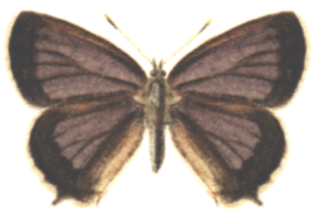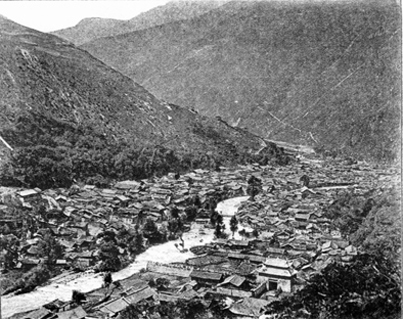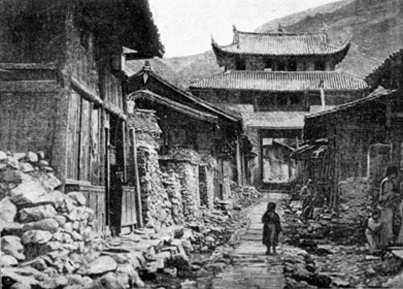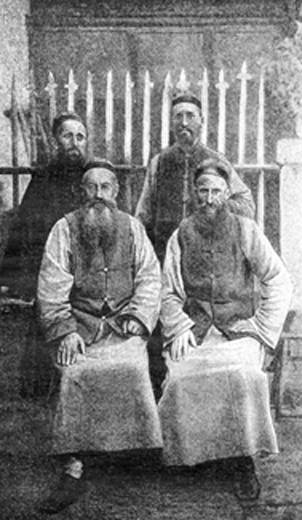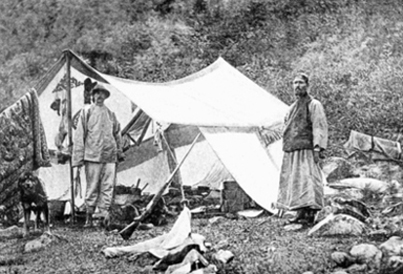Paper read at the International Vladimir Nabokov Symposium St. Petersburg, July 18, 2002
The finds described in this paper finally led to the book
»Nabokov reist im Traum in das Innere Asiens
In collaboration with Sabine Hartmann
Reinbek: Rowohlt Verlag, 2006
320 pages, 51 illustrations, 1 map
Chinese Rhubarb and Caterpillars
by Dieter E. Zimmer
AS THIS IS the butterfly section of this conference, you will expect to hear something about butterflies in Nabokov’s life and work. I am afraid I will have to disappoint you. Nor am I going to even approach grand topics like butterflies & art or butterflies as symbols. I want to simply tell you about a streak of luck I had when trying to clarify a few tough—one might even say hopeless—points in some of Nabokov’s works.
I know this is lowly work, and I do not pretend those points are of importance to the general Nabokov reader. You can very well enjoy and appreciate Nabokov without even noticing problems of this sort. Still it is nice to know even little things. It enhances your enjoyment. And if you have to go very far to find a certain small pebble, for you it is transformed into a beaming nugget. My fellow translators and annotators will probably agree that those tricky minor points pose as legitimate a challenge as the noble problems of interpretation. If you get them wrong, you are bound to get everything wrong.
It is going to be a rather convoluted and exotic story.
Almost forty years ago I translated Nabokov’s story Pilgram/The Aurelian into German. At that time I knew next to nothing about Nabokov’s entomological involvement. When I came upon items like the label pinned under a butterfly that read “Tatsienlu, East Tibet—Taken by the native collectors of Father Dejean,” I was not aware of any problem. If there was Tibet, I guessed that somewhere there must also be “East Tibet,” ignoring centuries of strife between China and Tibet. Though I could not find it on any current map, I thought I had seen the name “Tatsienlu” before. But I was convinced that surely “Father Dejean” was Nabokov’s invention, and that if he was not, it would be beyond the powers of an ordinary mortal to find out who he was. A few sentences farther down, there he was again: “Father Dejean, stouthearted missionary climbing among the rhododendrons and snows, how enviable was thy lot!” Fiction, I probably thought. Very evocative image.
Some thirty years later, as I was getting ready to edit the German translation of The Gift with its many butterflies and moths, I thought I better determine beforehand what exactly they all are. Out of this compilation there developed my checklist of Nabokov’s Lepidoptera published by the Zoological Museum of Lausanne in 1994, and during the following seven years this in turn grew into the 400 page volume of my »Guide to Nabokov’s Butterflies and Moths, listing, referencing and annotating all the lepidoptera in all of Nabokov’s published works.
Among the many butterflies of The Gift, there is one that seems endowed with a special meaning. In Part 5, Fyodor Godunov-Cherdyntsev in a dream returns to his old Berlin lodging where he meets his dead father, the explorer Konstantin Godunov who had disappeared in Central Asia in 1917. He had last been seen alive in the “mountains of Tibet,” near a village by the name of Chetu, by a French missionary. Fyodor’s dream has transformed the bluish tulips on the yellow wallpaper of his modest rented room into swans and lilies, and its ceiling has become „wonderfully ornamented with Tibetan butterflies (there, for example, was Thecla bieti).”
So what and where was Chetu? I scanned all maps of Tibet I could get hold of in search of that village, but could not find any place whose name even remotely resembled it. Moreover, I was beset—and terribly misled, as it turned out—by the very first puzzle I had run into in Nabokov. That had been in 1960 when I translated The Real Life of Sebastian Knight. There is a handwritten Russian letter in it one of whose words the narrator cannot make out. The word seems to be ‘dot chetu.’ Neither I nor the Russians I asked had an explanation for it. It was Véra Nabokov who finally took pity on me and gave me a cue. The cue, of course, was to write ‘dot chetu’ in cursive Cyrillic characters and then to forget they were Cyrillic. What you get is Domrémy in Lorraine, the home village of Jeanne d’Arc. So was ‘Chetu’ somehow an illusion to Joan of Arc? False leads like this can cost you a lot of time. Worse still, you may never find out the lead was false and develop an elaborate theory of how precisely Konstantin Godunov, a Tibetan village and Joan of Arc are connected.
|
|
|
The butterfly Thecla bieti |
However, I quickly found the butterfly, Thecla bieti, whose modern scientific name is Esakiozephyrus bieti. It is a small hairstreak first described by the French lithographer, publisher and entomologist Charles Oberthür in 1886, and it appears to be very similar to the Purple Hairstreak of Europe (Quercusia quercus, L., 1758). A very inglorious insect, one that tends to be left out.
At first there seemed to be nothing special about bieti. But when I looked up the OD in Oberthür’s precious serial work, I came across something interesting. The specimens Oberthür had examined had been sent to him from Tatsienlu by a French missionary, Bishop Félix Biet. That meant ‘bieti’ was not an anagram of Tibet, as one might easily suppose. As he had done in other cases, Oberthür had named the hairstreak after the man who had sent him the specimens. Oberthür also expressed his gratitude to the other missionaries at Tatsienlu. One of them was “Father Déjean.” In the microfiches of the Biographical Archives I found a short biography of Félix Biet (who lived from 1838 to 1901 and spent nearly thirty years in Tatsienlu and vicinity), and my attention was drawn to Adrien Launay’s Mémorial de la Société des missions étrangères published in 1916. Here I found that stout-hearted missionary climbing between rhododendrons and snows: Léonard-Louis Déjean, born in 1846, who had come to East Tibet in 1870 and died in Tatsienlu of typhoid fever in 1906.
So I had the butterfly, knew there were missionaries in Tatsienlu who collected butterflies and that one of them was Déjean. I felt I wasn’t doing badly. Still I was puzzled. What about that Tibetan village of Chetu? What about the rhododendrons and snows of The Aurelian? What about all the other information on Tatsienlu in The Gift, again the rhododendrons in the snow mountains surrounding it, or the shavenheaded lamas roaming its narrow and crooked streets? Clearly, Nabokov must have had a source for all of this other than Oberthür’s profuse but reticent professions of gratitude. I had no idea what this source might have been and how to find it.
A few years later, I was faced with a number of further nasty problems, all connected with mimicry. Nabokov considered mimicry to be one of the pure pleasures of nature, serving no other purpose than to please humans by the sheer beauty of the thing. He took this to prove that Darwin’s theory of evolution by natural selection with its grim utilitarianism was wrong. To assess the justification of Nabokov’s anti-Darwinian stand, I collected all instances of mimicry mentioned in his writings in order to see for myself if any of them could be termed purposeless, non-utilitarian. Most of them were well known from the literature on mimicry and crypsis and presented no threat to Darwinism whatsoever. However, there were three strange cases mentioned nowhere in the literature and unknown to the experts I wrote to.
One was that of a “cunning butterfly in the Brazilian forest which imitates the whir of a local bird.” Taking the Brazilian forest as a cue, I read Henry Walter Bates’s The Naturalist on the River Amazons. Bates, of course, was the one who introduced the concept of mimicry proper, and from a remark by Thomas Barbour of Harvard I knew that Nabokov had known the book and must have loved it. So I was not very surprised to find what I was looking for. It was a hawkmoth resembling a humming-bird, with no mimicry involved at all. Hawkmoths and hummingbirds have independently evolved a similar mode of whirring flight that allows them to hover above a flower to sip its nectar.
The second case was a caterpillar purposelessly imitating a yellow flower. After studying many botanical and entomological species and genus catalogs from 250 years I felt safe enough to conclude that Nabokov had invented both the moth (Pseudodemas tschumarae) and its food plant (Tschumara vitimensis). All that could be said was that the moth probably was a noctuid and that the imaginary case must have happened in the middle of Siberia. An invention cannot serve as a scientific proof. That finished the second case.
So there remained only one case to refute Darwinism. It was the strangest of all. We are back in the region of Tatsienlu. Konstantin Godunov is collecting butterflies, and near him there are “some witch doctors [who] with the wary and crafty look of competitors were collecting for their mercenary needs Chinese rhubarb, whose root bears an extraordinary resemblance to a caterpillar, right down to its prolegs and spiracles—while I, in the meantime, found under a stone a caterpillar of an unknown moth, which represented not in a general way but with absolute concreteness a copy of that root, so that it was not quite clear which was impersonating which—or why.” (The Gift, p.123) Now what for heaven’s sake was this? Had Nabokov invented that too?
At this point the streak of luck set in. I wanted to picture Nabokov’s important butterflies in the final version of the Butterfly Guide and did not particularly like the picture of Thecla bieti that accompanied Oberthür’s OD. Nobody else seemed to have ever figured it, except for Seitz, of course, but the picture in his monumental reference work was just a close copy of Oberthür’s. So I decided I might as well have a look at a really rare book, Butterflies from China, Japan and Corea (1892-94) by the British explorer and collector John Henry Leech. He is mentioned in The Gift as one of Godunov’s friends, and as he had been a wealthy man I suspected his book would have superior illustrations. One day I found a copy of this precious work innocently standing in the open stacks of a Berkeley library. It surely has wonderful figures, but alas, there was no Thecla bieti.
|
|
|
Chetu (Zheduo) sketched by Gustav Kreitner, c.1885 |
However, I did not even get around to feel disappointment for in Leech’s introduction there was something that immediately made me go on the alert. There were photos of Tatsienlu made in 1890. I learned they had not been taken by Leech himself but by another English explorer by the name of A.E. Pratt. Leech on his long collecting trip to East Asia had chosen to go directly to Corea and commissioned Pratt to make the difficult journey up the Yangzi River and as far as he could into Tibet. The farthest point Pratt had reached was, guess, Tatsienlu. Or rather it was a little Tibetan hamlet of some four wooden huts and a kun-quan (a sort of primitive hostel for traveling Chinese mandarins) ten miles west of Tatsienlu. It is on the old trade road from Sichuan to Lhasa called “Tea-Horse” because the main trade was brick tea going west and horses going east. The name of this place was Chetu (Zheduo in Hanyu Pinyin spelling). It never was on any map. However, there even happens to exist a picture of it from the 1880s, in the book about Count Béla Széchenyi’s expedition to Central Asia, section “Geographie,” by the Austrian geographer Gustav Ritter von Kreitner.
So unexpectedly there was the place where Konstantin Godunov had been seen for the last time, a place I had thought to be fictitious. But why Thecla bieti?
|
|
|
The valley of Tatsienlu (Kangding), photographed 1890 by A.E. Pratt |
|
|
|
Street and South Gate of Tatsienlu, photographed 1890 by A.E. Pratt |
Pratt I learned had written a book about his voyage from Shanghai to Tatsienlu. The title is To the Snows of Tibet through China, and it was published in 1892. Pratt exaggerated a little when he claimed he had reached the snows of Tibet. Even in his times, the town of Tatsienlu and the surrounding snow mountains were clearly on Chinese territory, but with a strong Tibetan element, including several Lamaist monasteries. It was a border town, appearing as the first Chinese place if you came from Tibet and as the first Tibetan place if you came from China. That is why there were French missionaries present in 1890. The had set out to evangelize Tibet but had been kicked out violently and settled as close to Tibet as possible, in Tatsienlu. Their life there was not easy. The local lamas strongly disliked them, and the Chinese tolerated their presence but eyed them suspiciously. The Chinese name, by the way, since 1913 has been Kangding—that’s why it was not on any current map. However, ‘Tatsienlu’ remains a great name in natural history. Many species, especially insects and rhododendrons, were described from there, thanks to the assiduous collecting of the French missionaries.
I found a library copy of Pratt’s book, unlawfully xeroxed it and immediately realized I had hit upon a gold mine. It became obvious that Nabokov must have known the book and that he had borrowed more than a dozen details from it when imagining Konstantin Godunov’s Central Asian voyages, including two whole sentences and one whole paragraph. There were the crooked streets of Tatsienlu, the shaven-headed lamas, the rhododendrons, the pine forests “draped in lacy lichen,” the snows, the medicine collectors. It clearly had been a major source, just like Grum-Grzhimailo and Przheval’skii, but even more recondite.
There also was ‘Father Martin’ (though he turned out to be the wrong one) and the four Catholic missionaries in Tatsienlu who had been of great help to Pratt, among them Bishop Biet and Father Déjean. Pratt in all of his book mentions just three or four specific butterflies. One of them is the Imperatorial Apollo and its pupa that also shows up in The Gift. The other is Thecla bieti. Pratt had found it in Chetu. This is what he says about it: “The district [of Chet-tu] is rich in Thecla, and I have taken as many as 300 T. bieti in one morning with my forceps off the droppings of the baggage animals on the Lhassa road.” (Pratt 1892, p.144-5) A place where you can pick hundreds of butterflies off the road surely must have seemed a collector’s paradise to Nabokov.
But that was not all yet. In Pratt’s book there also was the rhubarb and the caterpillar. Speaking of some mountain meadows to the south of Tatsienlu, he writes: “The medicines collected here are rhubarb, Tchöng tsäo (Sphaeria sinensis), a plant the root of which bears an almost exact resemblance to the body of a caterpillar, and pey-mou …” (p.1 87-8) So here was the solution, but unfortunately it made the case still more mysterious. I checked all books I could find that had anything on rhubarb. There was plenty on Chinese medicinal rhubarb which is Rheum palmatum, a widely used laxative, but there just was no rhubarb species by the name of sinensis and none whose root was deemed worthy of mention because it looked like a caterpillar.
|
|
|
Chinese medicinal rhubarb |
So to my dismay one propitious solution had only led to the next mystery. This is where the Internet comes in. I was spending a few days at Lake Tahoe skiing, there was a stormy day with the mountain of Heavenly closed, and I was in bad humor because there were no bookstores or libraries anywhere around where I could have pursued my study of the roots of rhubarb and other urgent problems. As I sat in my motel room with nothing to do, I thought I might as well go online and try the Web. At that time it was not yet easy to hook up your laptop to a motel phone line. When I had made it work, I first looked up all I could find about rhubarb. There was plenty, but nothing about any peculiar roots. Then I searched for the Latin name Pratt gave. There was no plant genus by the name of Sphaeria, but there were dozens of plants called sinensis. As genus names have been switched frequently, Sphaeria might have been just one of the many obsolete names that had not made it into the Internet yet. But unfortunately no sinensis species held any promise. None of them had anything to do with rhubarb. As was to be expected, the Chinese name in Pratt’s quaint old spelling brought no results either. After a few hours of this, I was about to give up and shut down the computer. Then I thought again.
Search engines willy-nilly go for strings of characters completely oblivious of their meaning. By human standards, the method seems utterly stupid. We always search for meanings, not for letters. But it is exactly this stupidity that makes search engines ignore the boundaries of nature and the firm categories of human knowledge that sometimes hem us in. They are more uncompromisingly associative than we ever permit ourselves to be. When typing in the keywords ‘sinensis’ and ‘caterpillar,’ I had noticed a few pages coming up which I had considered irrelevant because they dealt not with any plant but with some fungus.
So I opened the lid of my notebook again to have a closer look at that fungus. And right away there it was, Cordyceps sinensis, a medicinal fungus much prized in China, Dong Chong Xia Cao or simply Chong Cao in Pinyin spelling, meaning ‘winter-worm summer-grass.’ Its root does not mimic a caterpillar, it actually is the carcass of one. The fungus infests the caterpillars of a certain unprepossessing genus of ghost moths (Hepialus) during their underground life, kills them, devours them and grows out of them like a stalk of brown grass.
|
|
|
Winterworm Summergrass (Chong Cao) |
In short, in winter it’s a worm, in summer it’s a blade of grass. It is said to once have been reserved for the Emperor. Nowadays it is still collected, but also cultivated on a big scale as a sort of vegetable in a Chinese recipe called Medicine Duck and as a general tonic or “energizer” that is said to have helped a Chinese women track team win international competitions. That is why it figures in so many Web pages, for example in the one the picture here came from. Passing through San Francisco on my way back from Tahoe, I went to a medicine shop in Chinatown, bought a few pieces of it (it is expensive) and ate it, but felt no energizing effect.
The find was lucky enough but posed another problem. Why on earth had Nabokov taken a mushroom for a kind of rhubarb? I went back to the two passages in Pratt’s book that dealt with ‘winter-worm summer-grass’ and saw what had happened. Nabokov had pardonably misunderstood the syntax of Pratt’s sentence. He had taken as an apposition what actually was an enumeration. The Chinese witch doctors in the mountains above Tatsienlu were collecting “rhubarb, Chong Cao, … and ‘pey-mou.’” (Pey-mou, or Bei Mu, by the way, is Fritillaria roylii, the bulb of which is used against respiratory disorders in TCM.) Nabokov obviously had believed Chong Cao to be an explication of Chinese rhubarb while in reality it was some other item the medicine collectors were after.
|
Four Westerners in Tatsienlu, 1890, photographed by Prince Henri d’Orléans. From left: Father Déjean, Bishop Félix Biet, the American Tibetologist W.W. Rockhill, Father Souliè (?) |
|
With these finds, of course, the last case of mimicry that might have refuted Darwinism had evaporated. The fungus was not imitating a caterpillar nor vice versa, its root actually was a caterpillar, or the husk of one. Pratt had no idea what was the moth that fell prey to the fungus because that became known only after the times of his trip to China. I am not certain Nabokov knew, but he might have. That’s another unbelievable story. One night Charles Oberthür, the author of Thecla bieti and many other butterflies and moths the French missionaries at Tatsienlu had sent him specimens of, noticed a strange insect in his garden in the city of Rennes on the west coast of France, caught it, killed it, prepared it and examined it. He was puzzled. He had never seen the species before and did not know what it was. He sent it to some fellow experts who had no idea either. So he very reluctantly gave it a name, Hepialus armoricanus, that is, the Hepialus moth from Brittany. In 1909, he published the name, but instead of a proper description he only outlined the conclusion he had unwillingly drawn from his qualms. What he said was that he considered the moth he had caught in his Brittany garden to be a native of Tibet that had grown out of the husk of an unknown Tibetan caterpillar.
Nabokov must have read Pratt’s book before he wrote Pilgram, that is before 1930, years before he began to work on The Gift. Perhaps Pratt’s book was the trigger for thinking up that Berlin insect dealer confined in his narrow world, vainly dreaming of the rhodendendrons and snows of Tatsienlu and in the end turning out to be less stout-hearted than Father Déjean.
|
|
|
A.E. Pratt (right) in his camp at Mosimien (Moximian) c.75 km south of Tatsienlu |
This may have been the nucleus of Chapter 2 of The Gift. On October 15, 1929, a few weeks after his butterfly hunting trip to the Pyrenees, Nabokov and Véra went to the German Entomological Museum, then in Berlin-Dahlem, now in Eberswalde, in company of his entomologist friend Nikolai Kardakoff (born 1885 near Wyatka, died 1973 in Berlin). There is Nabokov’s name on the guest list of that day (“V. Nabokoff mit Frau”), along with Kardakoff’s. Between them there is the signature of one “A. Kricheldorff". Now this certainly is the Berlin naturalist and some-time insect dealer Adolf Kricheldorff who had been in Tatsienlu with Pratt. From Kricheldorff Nabokov may have heard about their joint expedition to western China and of Pratt’s obscure book which Nabokov borrowed soon after from the Prussian State Library where he used to go for scientific literature. Yes, it held a copy. It has survived the bombs of the war, the evacuation to a salt mine, the excavation to the attic of the castle of Marburg and the splitting of the library into east and west. I may have been the first reader who asked for it after Nabokov. And since I discovered a light pencil mark in the margin next to Chong Cao, the caterpillar fungus, I like to imagine it was Nabokov’s.*
What is the message of all of this queer lore for Nabokov studies? To my mind, there are two messages, a specific and a general one.
In Nabokov’s last novel, there is a brief exchange between the narrator and his first wife. She asks, “What do you call ‘genius’?” His answer is, “Well, seeing things others don’t see. Or rather the invisible links between things.” I know you must not confuse the narrator with Nabokov, but I believe that in this instance Nabokov is voicing an important idea of his own. What I shall simply call the Tatsienlu complex in The Gift is a good example of an associative network of such “invisible links” connecting the death of Konstantin Godunov, the town of Tatsienlu, the village of Chetu, the French missionaries and Thecla bieti. It seems one of Fyodor’s more or less subconscious fancies had been that his father had not perished but had stayed on in Tibet or China, just like the Belgian the two American bikers mentioned in The Gift whom his father had met in the Gobi desert and who had become a Chinese mandarin (I am speaking of Paul Splingaert in the town of Sazhou, now Jiayuguan in Ganzu, at the Western edge of the Chinese empire). That may be the reason why Fyodor’s dream strangely vested his father “with a gold embroidered skullcap,” that is, with a mandarin’s cap.
The other message is that before you begin to do any trick-reading or to hunt for symbols and for remote literary analogies, it may sometimes pay to attend to the facts, even if you have to go as far as Tatsienlu.
![]()
* When I tried to inspect the book once more in 2002, the copy could not be located. In 2005 it turned up again.
Works Cited
Kreitner, Gustav. “Geographie.” Die wissenschaftlichen Ergebnisse der Reise des Grafen Béla Széchenyi in Ostasien 1877–1888, vol. 1. Wien: Hölzel, 1893.
Leech, John Henry. Butterflies from China, Japan, and Corea. London: Porter, 1892-94.
Oberthür, Charles (ed). Études d’Entomologie, 11, 1886: 19-20.
Oberthür, Charles (ed). Études de Lépidopterologie comparée, 3, 1909: planche XXV, no. 135.
Oberthür, Charles. “Observations sur l’Hepialus armoricanus.” Bulletin de la Société entomologique de France 1909: 250-2.999
Pratt, A[ntwerp] E[dgar]. To the Snows of Tibet through China. London: Longmans, Green, 1892, reprint Taipei: Ch’eng Wen, 1971 and New Delhi: AES, 2001.
Zimmer, Dieter E. “Nabokov’s Lepidoptera.” Catalogue de l’exposition Les Papillons de Nabokov. Ed. Michel Sartori. Lausanne: Musée cantonal de Zoologie, 1993: 25-171
Zimmer, Dieter E. A Guide to Nabokov’s Butterflies and Moths 2001. Hamburg: Zimmer, 2001.
